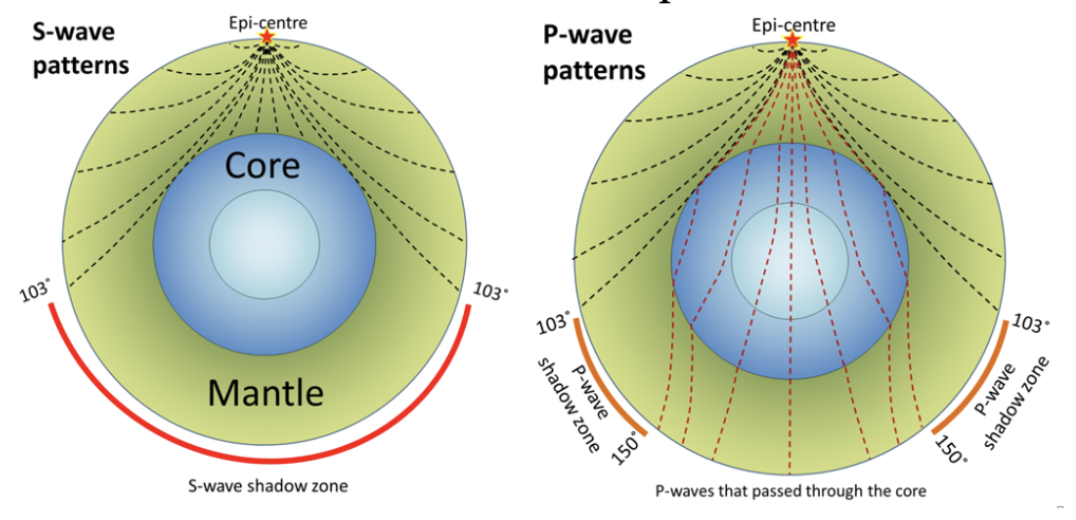Mineral and Rock Test
1/42
Earn XP
Description and Tags
Name | Mastery | Learn | Test | Matching | Spaced |
|---|
No study sessions yet.
43 Terms
Crust
Thin outer layer
Solid and Brittle
Moho = Mohorovicic Discontinuity
Part of the asthenosphere
Mantle
Upper part - Asthenosphere
Lower part - Mesosphere
Plasticity (Solid but can flow like a liquid)
Makes up 85% of the Earth's volume
Temperatures range from 500 to 900℃ in the upper portion to over 4,000 ℃ lower down
85%
What percent of Earth’s volume does the mantle make up?
Peridotite
What is the mantle mostly made of?
Asthenosphere
Upper mantle where convection can form; rests below the lithosphere
Lithosphere
Brittle crust and upper mantle; rests on top of asthenosphere
Plasticity
Solid, but can flow like a liquid
Magnetic field
The interaction between Earth’s inner and out core creates Earth’s ______________
5400 C
Average temp of Earth’s core
80% Iron and 5% Nickel
What is Earth’s core made of?
Inner core
Solid part of the core
Outer core
Liquid molten part of the core
Differentiation
the separation of materials based on their density (occurred during planetary accretion)
P waves
waves that travel through liquids and solids and gasses
S waves
waves that only travel through solids.
uwu
check out this pic and say uwu

oxygen, silicon, and aluminium
three most common elements in Earth’s crust
Iron, Oxygen, Silicon, and Magnesium
four most common elements
Native Elements, Silicates, Carbonates, Oxides, and Sulfides
five main mineral groups
mineral
What is….
Naturally occurring
Inorganic
Solid
Crystalline structure
The same chemical composition throughout.
chemical composition and atomic structure
what gives minerals their different physical properties
color
✨Guess That Mineral Property✨
Is the mineral yellow? light green? black?
crystal structure
✨Guess That Mineral Property✨
“The particular repeating arrangement of atoms throughout the crystal” (University of Waterloo)
luster
✨Guess That Mineral Property✨
How a mineral's surface reflects light
hardness
✨Guess That Mineral Property✨
Does it break easily? Can you scratch it with your fingernail? Does it scratch glass?
streak
✨Guess That Mineral Property✨
Use a _____ plate to find the powdered colour left behind by the mineral
fracture or cleavage
✨Guess That Mineral Property✨
Does it break smoothly along specific internal planes? Or does it just break randomly with few/no smooth surfaces?
precipitation process
when a mineral forms by crystallization from a solution
normally formed by the evaporation of water.
magma process
formed by the cooling of magma causing the atoms within the liquid magma to slow down and bond into solid materials and minerals.
more time cooling = larger crystals
pressure process
when minerals change deep within the earth at tectonic plates in order to form new minerals.
no melting, the minerals break and change their bonds.
“recycling” of minerals
Silicon and oxygen
Silicates all contain…
Carbon and Oxygen
Carbonates all contain…
A metal and Oxygen
Oxides all contain…
A metal and Sulfur
Sulfides all contain…
one element
How many elements do native elements contain?
False, they’re inorganic
True or False: minerals are naturally occurring and organic
rock
a group of minerals bound together
True
True or False: a mineral is in a rock but a rock isn’t in a mineral
Igneous rocks
No obvious patterns
No fossils
No reaction to hydrochloric acid
Form from cooling and solidification of magma/lava
Can be intrusive or extrusive
Sedimentary rocks
Rocks are made from sediments by a 4-step process
Contain strata
Often contain fossils
Different minerals inside of the rock–with varying shapes and sizes of internal minerals
Metamorphic rocks
form from heat and pressure being applied to a “parent rock”
Have foliation
Yar
Yar or Nar: rocks must be solid
Nar
Yar or Nar: rocks must have a definite crystalline structure